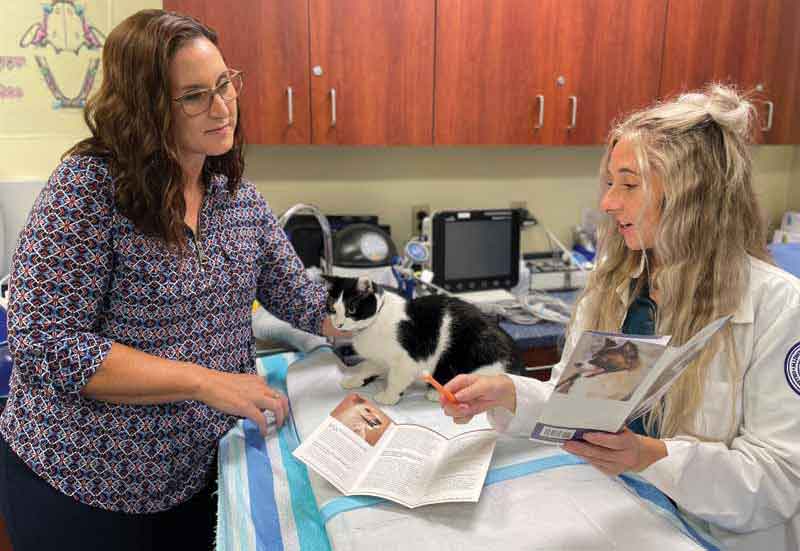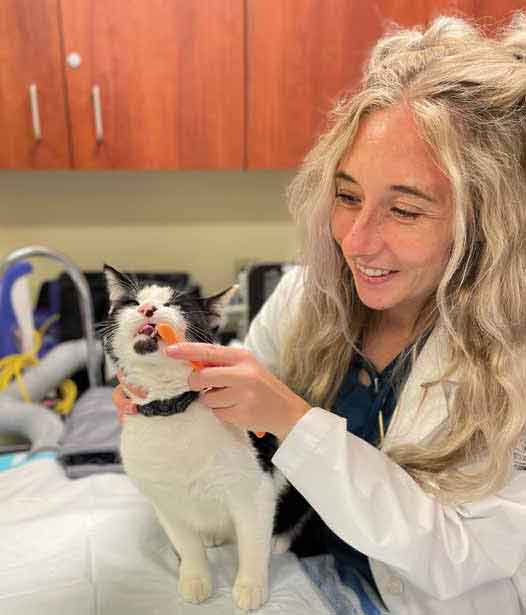
Photos courtesy Stefanie Perry
The veterinary team works hard to educate pet owners in a variety of areas. Making the recommendation to brush a pet’s teeth daily is an enduring requirement alongside vaccines, parasite testing, and preventive medications.
Periodontal disease is estimated to be present in 86 percent of dogs,1 and being the most prevalent disease process in our patients, is worthy of deliberate education and demonstration.
Recognizing the limitations pet owners face when preventing periodontal disease is a key part of client communication and education. As with many other disease processes, periodontal disease can be interrupted with diligence and the right approach to treatment, prevention, and consideration of hereditary factors.
Daily brushing
The persistent challenge in veterinary dentistry is a lack of daily tooth brushing in our patients. Most dogs and cats do not receive daily brushing, a type of mechanical plaque removal. The disruption of plaque is the most vital facet of preventing periodontal disease.2 This lays the burden upon the pet owner to provide consistent prevention between cleanings.
Tooth brushing has been proven to be the gold standard in preventing periodontal disease, and although it is widely accepted in human dentistry, the importance of daily brushing is not recognized by most pet owners. As early as 1986, a comparative study among 12 beagles brushing daily, thrice weekly, and once a week showed the minimum frequency of brushing was three times per week before the presence of gingival inflammation was noted.3
Despite its efficacy, there are many obstacles for owners when attempting to perform daily brushing.
Factors that prevent brushing
An obstacle for pet owners is implementing daily brushing into their already busy lifestyle. While this falls under poor owner compliance, most veterinary professionals can empathize with the challenge of creating the habit and maintaining the practice of brushing every day.
Empathy on this level can relieve the frustration of dealing with patients suffering from severe periodontal disease due to poor home care. Use of the truism, “If it was easy, everyone would do it” would apply here. Passing judgment on pet owners is detrimental to our relationship with them, as well as to our ability to make recommendations they can trust.
Be cognizant of a pet owner’s physical or emotional impairment as a barrier to daily care. Physical limitations are often a factor in the case of elderly owners or elderly patients where attempts at brushing are complicated and perhaps dangerous.
Challenges for clients that we cannot appreciate may also play a role in poor home care. Even in young and healthy animals, patient compliance is also a consideration when a pet will not tolerate brushing due to exuberance, anxiety, or aggression. Pet owners rely on the veterinary team to provide demonstrations and training resources to acclimate pets to the invasive nature of tooth brushing.
Implementing tooth brushing gradually over an extended period is more likely to reach a positive outcome and sustainable routine. Early intervention through training with a toothbrush during puppy and kitten visits can make a big difference to their ability to do it at home over the pet’s lifetime.
Home care options
Brushing or other mechanical disruption of plaque is the gold standard. Other options are considered passive because although they require a commitment to daily use, they can be given to the pet and have no other interaction from the pet owner for the product to be effective.
The use of any dental care product, with or without Veterinary Oral Health Council (VOHC) acceptance, must be used as directed by the manufacturer to reach its advertised efficacy. As with tooth brushing, inconsistent use of the products will not achieve the desired effect to prevent dental disease.
- Chews. There are numerous dental chews on the market, the majority of which are available over the counter in stores and online. Adhering to VOHC-accepted products prevents pet owners from using inappropriate chewing products, such as nylon toys, hooves, antlers, and other items associated with tooth fractures. Chews on the VOHC list include vegetable-based, antimicrobial- or enzymatic-impregnated, associated with a barrier substance, or textured and/or porous to simulate brushing. A study on enzymatic rawhide chews showed significant short-term plaque reduction, but required long-term studies to determine if consistent long-term use would be beneficial.6
Although chews would be considered passive prevention, it comes closer to actual mechanical disruption of plaque and is, therefore, the best alternative to brushing.
- Treats. Another VOHC-accepted option are treats or biscuits that contribute to good oral health. When owners are prone to treat their pet as part of the human-animal bond, it stands to reason they should use a product that also promotes good oral health.7
- Diets. Several food manufacturers offer dental beneficial products that they have evidence backed results when the pet is fed their diets exclusively. A dental diet is effective when it simulates tooth brushing through the shape and texture of the kibble, providing plaque disruption daily. To be clear, a commercial diet simply labeled “dental” is not equivalent to a product approved by the VOHC. Use of a proven diet can be an adjunctive option for pets very prone to periodontal disease as an added layer of prevention.
- Chemical prevention components. Zinc salts, organic polyphenols, and calcium chelators are a few examples of active ingredients in products that change the environment in the oral cavity to prevent the formation of plaque and/or tartar.8 A commercially made dilute chlorhexidine oral rinse can also be used to control the bacterial load. A company also makes varied forms of a tasteless zinc ascorbate in the vehicle of a gel, wipe, or rinse.4
Using these products in conjunction with active brushing may be the most efficient combination. These ingredients are overall inert and can be used long-term as a primary or secondary option for non-invasive prevention. These and other natural substances can be found in water and food additives, which serve as a simple passive method of prevention.
- Sealants. Barrier sealants act as a physical partition between plaque and the periodontal tissues to delay the invasion of bacteria into the sulcus. There are currently two products on the market that provide this protection. The first can be applied after a comprehensive oral health assessment and treatment (COHAT) but requires application on a weekly basis thereafter. The other is applied after a COHAT and lasts up to six months. The former creates an electrostatic barrier to keep plaque from entering the sulcus.
The latter option prevents the presence of plaque and tartar in the sulcus as the primary function, but must be applied under general anesthesia and remain in the sulcus to be effective. This product is a hydrophilic polymer, which allows water and oxygen into the sulcus and promotes an aerobic environment,9 making the sulcus inhospitable to anaerobic bacteria which are associated with periodontal disease.
Choosing between the products depends heavily on the ability of the client to apply a weekly product that is or is not palatable, while also considering the total cost of each option. Use of a barrier sealant after a COHAT is the best time to institute tooth brushing (per manufacturer recommendations) or other products while they have a clean slate.
Multi-modal approach
In the same way we approach pain management for our dentistry patients, we must approach periodontal disease prevention through one or more modalities. The first line and gold standard of prevention is daily brushing and should always be the primary recommendation for dental home care. If necessary, brushing can be somewhat intermittent if performed at least thrice per week. The added layer of using other prevention products on the brush, even if performed infrequently, could be the most synergistic approach for patients between their professional dental cleanings. All types of prevention must be accompanied by annual COHAT procedures. In the most severe cases, biannual professional cleanings may be required even with consistent prevention practices.
Dynamically choosing dental prevention cooperatively with the pet owner will best serve our patients, using all the tools available for each client education interaction. Our most vulnerable patients (small breeds and brachycephalic breeds) are by far the most deserving of multiple options to prevent periodontal disease and chronic pain. Try to go beyond a generic brochure or brief mention in a discharge note and have conversations with each client about how periodontal disease can be prevented through several different means. Addressing pet owner concerns about ease of use, frequency, cost, and other factors will facilitate good outcomes for our dog and cat patients.
Stefanie Perry, CVT, VTS (Dentistry), has 19 years of experience in the veterinary field. Perry is the owner and operator of VetNerd Dentistry Training LLC, providing lectures and clinical skills labs in general practices. In 2015, Perry accepted a position at Midwestern University College of Veterinary Medicine, where she continues to oversee students and conduct clinical skills labs in veterinary dentistry and anesthesia. She is a member of the Academy of Veterinary Dental Technicians, where she is the website committee chair and liaison to the Committee on Veterinary Technician Specialties. Perry is also the president and co-founder of the Arizona Veterinary Technician Association and the Arizona NAVTA State Representative.
References
- Stella JL, Bauer AE, Croney CC. A cross-sectional study to estimate prevalence of periodontal disease in a population of dogs (Canis familiaris) in commercial breeding facilities in Indiana and Illinois. PloS One 13, no. 1 (2018): e0191395. https://pubmed.ncbi.nlm.nih.gov/29346448/
- Gorrel C. Veterinary dentistry for the general practitioner. London UK: Elsevier Science Limited, 2004.
- Tromp JAH, Jansen J, Pilot T. Gingival health and frequency of tooth brushing in the beagle dog model: Clinical findings. Journal of Clinical Periodontology 13, no. 2 (1986): 164-168. https://pubmed.ncbi.nlm.nih.gov/3455949
- Niemiec, Brook A. Veterinary Periodontology. Ames, IA: Wiley Blackwell, 2013.
- “Protocols and Submissions.” Veterinary dental product submission protocols from Veterinary Oral Health Council. Accessed May 27, 2023. http://vohc.org/protocols_submissions.html. Hennet, Philippe. Effectiveness of an Enzymatic Rawhide Dental Chew to Reduce Plaque in Beagle Dogs. Journal of Veterinary Dentistry 18, no. 2 (June 2001): 61–64. https://doi.org/10.1177/089875640101800201
- Hennet P. Effectiveness of an Enzymatic Rawhide Dental Chew to Reduce Plaque in Beagle Dogs. Journal of Veterinary Dentistry 18, no. 2 (June 2001): 61–64. https://doi.org/10.1177/089875640101800201
- Bellows J, Berg ML, Dennis S, Harvey R, Lobprise HB, Snyder CJ, Stone AE, Van de Wetering A. 2019 AAHA Dental Care Guidelines for Dogs and Cats. Journal of the American Animal Hospital Association 55, no. 2 (2019): 49–69. https://doi.org/10.5326/jaaha-ms-6933
- Larsen J. Oral products and dental disease. Compend Contin Educ Vet 32, no. 9 (2010): E4. https://pubmed.ncbi.nlm.nih.gov/20960410/
- Sitzman C. Evaluation of a Hydrophilic Gingival Dental Sealant in Beagle Dogs. Journal of Veterinary Dentistry 30, no. 3 (2013): 150–55. https://doi.org/10.1177/089875641303000303

